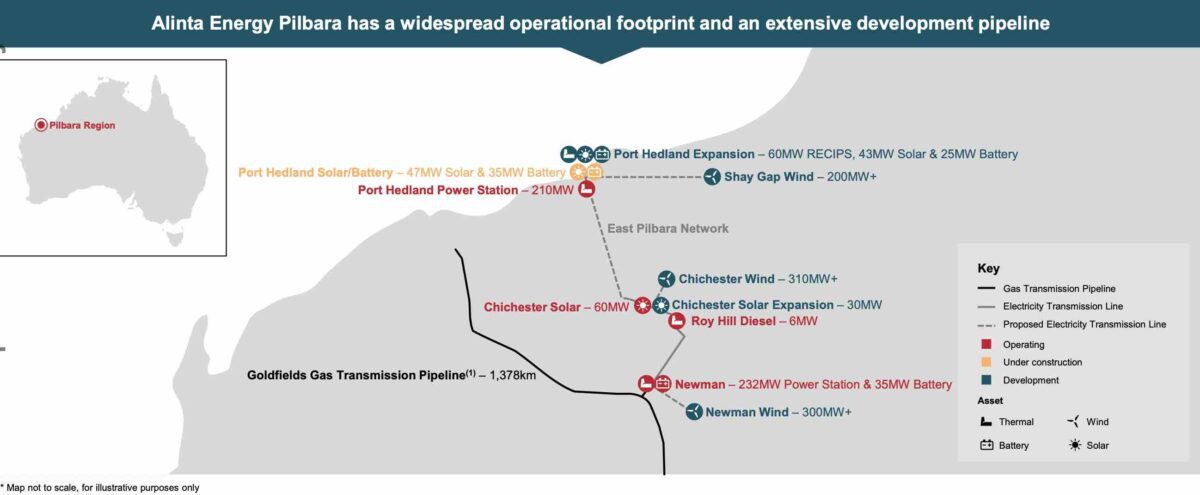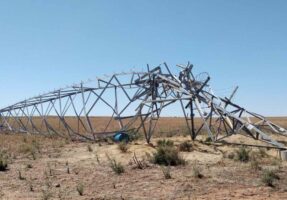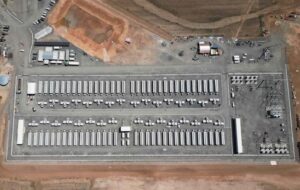Gas pipeline giant APA is poised for a multiple-billion dollar renewables play in the Pilbara mining region after agreeing to buy the local energy network and generation and storage assets from rival utility Alinta.
APA will pay an equivalent $1.7 billion (enterprise value) for the assets, which include $3 billion of new renewable and storage projects to help the big iron ore miners decarbonise their operations and seek new markets for their products.
Alinta says it is selling the assets so it can focus on other renewable and storage projects, including its giga-watt scale Spinifex offshore wind project near Portoland in Victoria, and the 900MW Oven Mountain pumped hydro project in NSW.
Pilbara is a fascinating case study for the transition to renewables. It has long depended entirely on either gas or diesel power, but has started a rapid transition to renewables and storage to reduce costs and secure a part of the intertational supply chain which is demanding low or zero carbon products.
The big mining groups and energy companies Alinta and Horizon recently agreed to end their “feudal” system of individual energy grids and work together to create a massive renewable energy zone.
See our story: Mining giants agree to end feudal energy grids and create massive renewables hub
Alinta’s assets will play a key role in what APA says will be a $15 billion transition to renewables in the region and away from fossil gas and diesel.
Alinta has already built a 60MW solar facility at Chichester, a 35MW, 11.4MWh big battery next to the Newman gas fired power station, and is currently building a 47MW solar farm and accompanying 35MW, 34.1 MWh big battery at Port Hedland.
Its projects include a 30MW extension to the Chichester solar farm, expansion of the Port Hedland solar and battery projects, and a series of new wind projects including 200MW wind project at Shay Gap, a 310MW wind project at Chichester, and 300MW of wind capacity at Newman.
APA says there are more than $3 billion of potential projects that it intends to develop in the region.
It is by far the company’s biggest push into renewables, although it has recently built the 88MW Dugald River solar farm near Mt Isa, and also owns the Badgingarra wind and solar complex and the neighbouring Emu Downs wind and solar complex in Western Australia, and the Darling Downs solar farm in Queensland.
“Today is a significant day for APA … the acquisition of Alinta Pilbara opens a new chapter,” APA CEO Adam Watson said.
APA is to raise $750 million in new equity to fund the acquisition, including $675 million in a rights issue and $75 million in a placement. It will refinance $993 million of debt. Stamp duty and transaction costs for the deal are currently estimated to be $86 million.
An APA presentation to analysts on Wednesday notes that 65 per cent of electricity demand in the Pilbara will be driven by the shift away from diesel used to power trucks, trains and mining operations in the region. Some 2,500 million litres of diesel will be consumed in the region this year.

APA says the generation of renewables in the Pilbara will increase 30-fold from just 0.4 terawatt hours in 2024, to 4.4 TWh in 2030 and to 14.8TWh in 2050.
It notes that all major mining groups will need to shift to net zero over the next few decades. Fortescue has the most ambitious target, wanting to reach “real zero” by 2030, while BHP and Rio Tinto have set strong interim targets.
The only big iron ore miner to set no interim target is Roy Hill, controlled by Australia’s richest person, Gina Rinehart, who is currently leading a campaign against renewables and for nuclear. APA notes that interim targets are a condition of Roy Hill’s environmental approvals, even if the target is not specifically stated.
APA says overall electricity demand in the Pilbara is expected to grow to 16.7 TWh by 2050, with more than 5GW of new wind and solar assets. Renewables, it says, will provide 89 per cent of total generation, with just 11 per cent for gas, which will provide firming and reserve capacity.

Watson used the presentation to push his company’s claims that gas will play a crucial role in the planned transition to renewables in the country’s main grid, which is heading towards the federal government’s target of 82 per cent renewables by 2030.
“We have a clean choice to make. We continue using coal, or we can use renewables that are firmed by gas,” Watson said.
“To take coal out, gas must come in.” APA is also convinced that gas will play a significant role in firming in the Pilbara, despite battery storage also being important.
“We still see gas underpinning the region’s reliability,” head energy solutions Darren Rogers said. “That’s because it’s capable of being turned on in minutes and able to be sustained for days.”
Most of the battery storage assets – such as Mt Newman – in the region have been used specifically to provide back up to the gas generators, allowing the number of units to run in reserve to be vastly reduced and deliver significant savings on gas consumption.
Alinta CEO Jeff Dimery said his company was proud of the Pilbara assets.
“We had a long-term vision and plan to decarbonise the Pilbara, which is well underway and underpinned by the strong renewables and emissions reductions targets of our customers and partners in the region,” he said.
David Leitch, ITK principal and co-host of RenewEconomy’s weekly Energy Insiders podcast, says that at first blush, APA’s acquisition of Alinta’s Pilbara assets is a clever transition move.
“(There is) lots of opportunity for APA to build renewable energy and gradually move its investor base from gas to a cleaner future. APA will also get experience in wind farm development and construction,” Leitch wrote on LinkedIn.
“The Pilbara is one of the few areas in Australia where we can get away from the regulatory regime that stops generators owning transmission networks and where the debate about transmission gets away from all the arguments we have in the NEM (Australia’s main grid).
“I guess the Pilbara is kind of an oligopoly where outcomes are negotiated between big players. Arguably this will result in faster and more efficient development than we seem to be able to accomplish in the NEM.”











